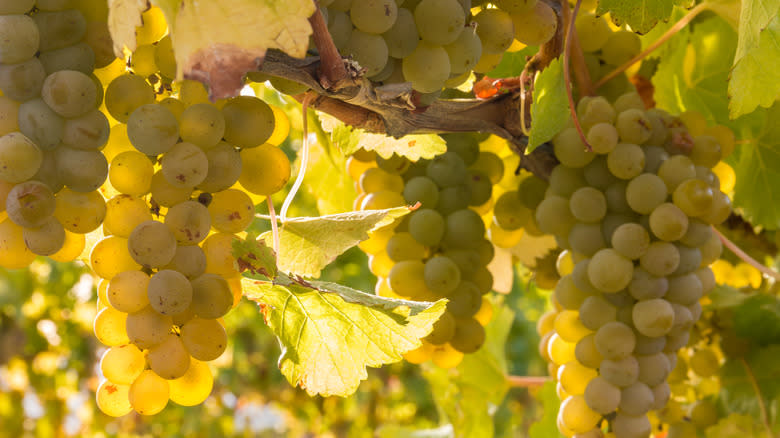Sauvignon Blanc Vs Pinot Grigio: The Difference Between The White Wines

There's nothing like sipping on a cool, refreshing glass of white wine after a long day, whether you enjoy it over a meal, sitting on your back porch, or in some other setting. In the United States, two prevalent types of white wine are sauvignon blanc and pinot grigio.
Both of these wines are reasonably dry yet still have some brightness and are often associated with citrus tasting notes. At the same time, they have a relatively high, mouthwatering acidity and an alcohol content hovering at around 12 to 14%. You can also find both wines grown in Italy, France, and California.
Despite all these similarities, these two white wines are also fairly distinct. For one thing, while both can be found in some of those same regions, they're most commonly thought of in conjunction with specific places. Plus, they differ in aromatics and subtle tasting notes. Because of that, the way you pair these wines with food can also vary.
Read more: 10 Of The Healthiest Beers You Can Drink
What Sets Sauvignon Blanc Apart From Pinot Grigio?

One of the significant differences between sauvignon blanc and pinot grigio concerns what regions are associated with growing these wines. Although it's not the world's largest producer of sauvignon blanc, New Zealand is the area most commonly associated with this particular variety and is still a major grower. On the other hand, pinot grigio is commonly associated with Italy. It's also not grown in as many regions as its counterpart.
Another difference between these two wines lies in their aromatics. Sauvignon blanc has a more pungent aroma than pinot grigio and often a higher acidity and more sour taste. In terms of the aromas, you'll notice citruses such as lemons and grapefruit, scents of fresh-cut grass, and passion fruit. However, while pinot grigio still has a bright acidity, it tends to be a little sweeter and has flavors of pears, green apples, apricots, and sometimes citrus flower and honeysuckle notes.
Because of the nuances in flavor and aroma between each wine, the way they work when paired with different foods also varies somewhat, despite both being fairly versatile. Pino grigio works particularly well with pasta and buttery meals. When pairing sauvignon blanc, seafood, chicken, and roasted veggies are good picks.
What About Other Similar Wines?

If you're a fan of sauvignon blanc or pinot grigio, there are a couple of other wines out there that may also strike your fancy. For starters, there's pinot gris, which is made from the same grape variety as pinot grigio. However, they have different growing regions, origins, and winemaking styles, thus offering different tastes. Pinot gris tends to be sweeter and has a lower acidity than pinot grigio while boasting a higher alcohol content.
You could also go for a Riesling. Rieslings tend to have similar tasting notes as pinot grigios, but they typically contain more sugar. They also tend to be more acidic and have a good aroma, giving them a flavor similar to sauvignon blanc. Still, they differ in that the tasting notes are more like citrus, crisp apple, and peach than the passionfruit notes of a sauvignon blanc.
Another choice could be a cabernet sauvignon. Although this is a red wine, it's actually related to the white wine because it's made from a hybrid of sauvignon blanc and cabernet franc grapes. This red alternative has a fuller body and tends to have blackberry, vanilla, and cedar aromas. While they're both dry wines, cabernet sauvignon isn't as acidic as its white counterpart. So, if you're a fan of either of these two wines, there are plenty of options for you to play around with regarding food pairings and tasting notes.
Read the original article on Daily Meal.

